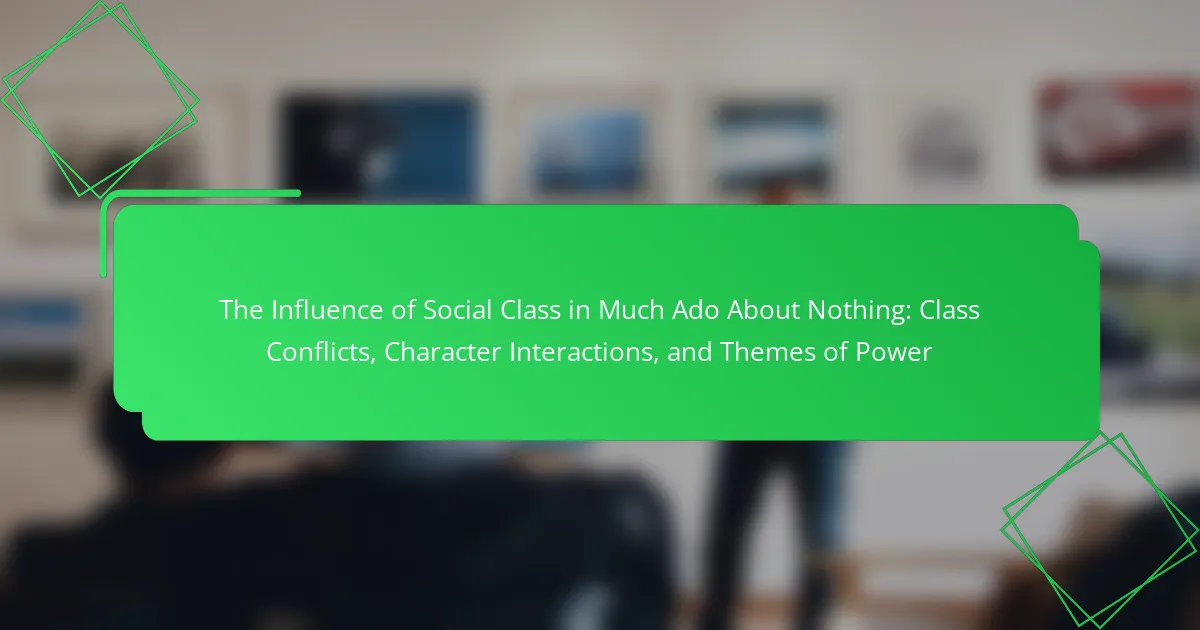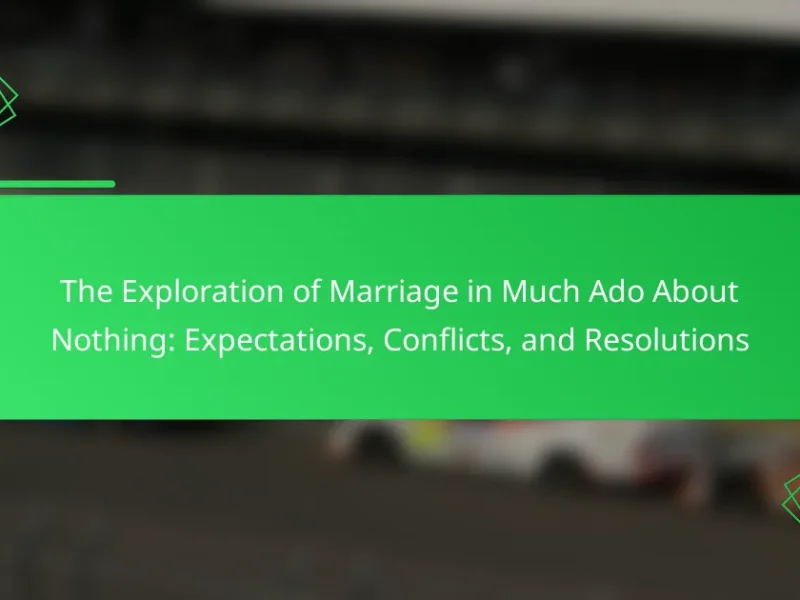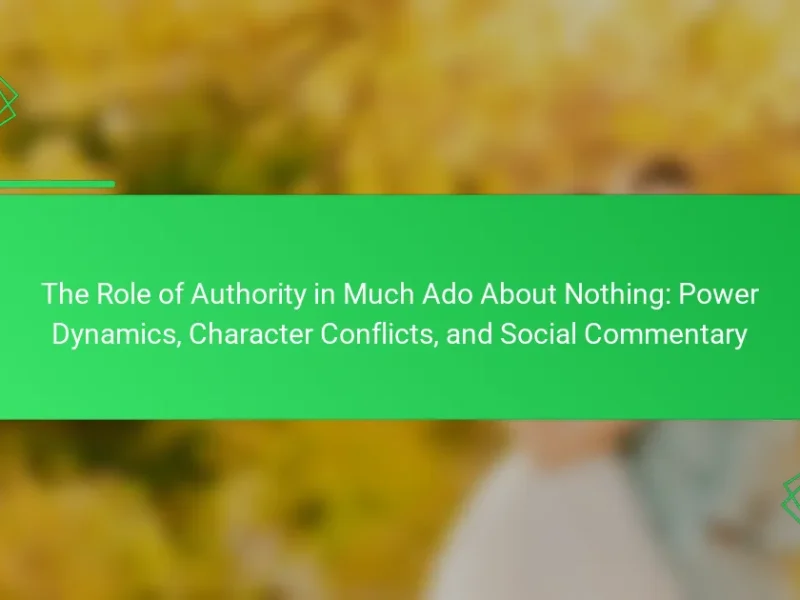
What is the significance of social class in Much Ado About Nothing?
Social class significantly influences character interactions and themes in Much Ado About Nothing. The play depicts a hierarchical society where noble status impacts relationships and social dynamics. Characters like Claudio and Hero represent the upper class, while characters like Dogberry and the Watch illustrate lower social standing. Their interactions often reveal class-based prejudices and expectations. For instance, Claudio’s public shaming of Hero reflects the power dynamics tied to social class. The play critiques these class distinctions, showcasing how they shape perceptions and behavior. Ultimately, social class serves as a lens through which the characters’ actions and societal values are examined.
How does social class influence character interactions in the play?
Social class significantly influences character interactions in Much Ado About Nothing. Characters from higher social classes exhibit authority and privilege. This is evident in the way they command respect and influence decisions. For example, Don Pedro’s noble status allows him to dictate social gatherings and romantic pursuits. Conversely, characters of lower social status, like Dogberry, are often marginalized and dismissed. Their interactions reveal the power dynamics rooted in class distinctions. The play showcases how these dynamics shape relationships and conflict. Social class creates barriers but also opportunities for characters to navigate their societal roles. Ultimately, class distinctions drive the plot and character development throughout the narrative.
What are the key social classes represented in Much Ado About Nothing?
The key social classes represented in Much Ado About Nothing are the nobility and the lower class. The nobility includes characters like Don Pedro, Claudio, and Benedick. They hold power and influence within the society depicted in the play. The lower class is represented by characters such as Dogberry and the watchmen. Their roles highlight the social hierarchy and the interactions between different classes. The play explores themes of class conflict and the dynamics of power between these social groups.
How do characters from different social classes interact with one another?
Characters from different social classes in “Much Ado About Nothing” often display tension and misunderstanding. The nobility, represented by characters like Don Pedro and Claudio, interact with lower-class characters such as Dogberry and the Watch. These interactions highlight social hierarchies and power dynamics. For example, the nobility often dismiss the opinions of lower-class characters. Conversely, lower-class characters exhibit cleverness and resourcefulness, as seen in Dogberry’s role in uncovering the truth. This dynamic reflects the complexities of social class interactions. The play illustrates that while class differences exist, characters can still influence one another’s fates.
What class conflicts arise throughout the narrative?
Class conflicts in “Much Ado About Nothing” primarily arise between the nobility and the lower classes. The interactions between characters like Don Pedro and the Watch highlight these tensions. Characters such as Dogberry represent the lower class, often facing ridicule from the nobility. The treatment of Hero by Claudio reflects class expectations and the power dynamics between genders and social standings. Additionally, the deception surrounding class status, as seen with the masked ball, emphasizes the fluidity and conflict of social roles. These conflicts serve to critique societal norms and highlight the disparities in power and perception within the community.
What events illustrate class conflicts in the play?
Class conflicts in “Much Ado About Nothing” are illustrated through several key events. The tension between characters of different social standings is evident in the interactions between Claudio and Hero. Claudio’s initial rejection of Hero due to perceived dishonor highlights class expectations and reputation. Additionally, the confrontation between Dogberry and the nobility showcases the divide between social classes. Dogberry’s comical authority contrasts with the serious demeanor of the higher class, emphasizing their differing perceptions of power. Lastly, the wedding scene serves as a critical moment where class distinctions lead to public shaming and conflict, ultimately revealing the fragility of social status. These events collectively underscore the impact of class on relationships and societal norms within the play.
How do these conflicts impact character relationships and plot development?
Conflicts in “Much Ado About Nothing” significantly impact character relationships and plot development. Class conflicts create tension between characters, influencing their interactions. For example, the disparity between noble characters and lower-class figures affects their perceptions and treatment of one another. This leads to misunderstandings and rivalries, driving the plot forward. Additionally, these conflicts reveal underlying themes of power and social hierarchy. The resolution of these conflicts often results in character growth and reconciliation, shaping the overall narrative. Thus, conflicts serve as a catalyst for both relational dynamics and plot progression.
What themes of power are explored through social class in the play?
The play explores themes of power through social class by highlighting class distinctions and their impact on relationships. Characters from higher social classes often wield more influence and authority. This power dynamic is evident in the interactions between noble characters and those of lower status. For instance, the treatment of characters like Dogberry reflects societal hierarchies. Furthermore, the play illustrates how social class affects perceptions of honor and reputation. Characters like Claudio and Benedick navigate these class structures to assert their power. Ultimately, the play critiques the rigidity of social class and its influence on personal agency.
How does social class shape the power dynamics between characters?
Social class significantly shapes the power dynamics between characters in Much Ado About Nothing. The distinctions in social class create barriers and influence interactions. Higher social status often grants characters like Don Pedro authority and control over lower-status characters. This hierarchy affects relationships, as seen in the interactions between Claudio and Hero. Claudio’s status allows him to assert dominance over Hero, impacting her agency. Conversely, characters like Dogberry, despite their lower class, can wield power through their roles in law enforcement. This complexity illustrates how social class is intertwined with themes of power and conflict. The social stratification in the play ultimately drives character motivations and conflicts.
What role does gender play in the themes of power and class?
Gender plays a significant role in the themes of power and class in “Much Ado About Nothing.” In the play, male characters often hold positions of authority and influence. They dictate social norms and expectations, reinforcing traditional power dynamics. Female characters, such as Beatrice and Hero, navigate these constraints in different ways. Beatrice challenges gender roles with her wit and assertiveness. Hero, on the other hand, embodies the submissive ideal, reflecting societal expectations of women. This contrast highlights the struggle for agency within a patriarchal framework. The play illustrates how gender intersects with class, as women’s social status often depends on their relationships with men. Ultimately, gender shapes the characters’ experiences and the broader social commentary on power and class dynamics.
How do social class distinctions affect the resolution of the plot?
Social class distinctions significantly impact the resolution of the plot in “Much Ado About Nothing.” The characters’ social standings influence their relationships and conflicts. For instance, the noble class, represented by characters like Claudio and Don Pedro, wields power and authority. Their status allows them to dictate social norms and expectations. Conversely, characters from lower social classes, like Dogberry, face marginalization. This creates tension and conflict, particularly in the misunderstandings that drive the plot. Ultimately, the resolution hinges on the reconciliation of these class differences. The marriages at the end symbolize a bridging of social divides, highlighting the theme of unity despite class distinctions. This resolution reflects the societal values of Shakespeare’s time, where class played a crucial role in personal relationships and outcomes.
What resolutions arise from class conflicts in the story?
Resolutions from class conflicts in “Much Ado About Nothing” include reconciliations and social harmony. Characters from different social standings find common ground through love and mutual respect. For instance, the union of Beatrice and Benedick bridges class divides. Their relationship showcases how personal connections transcend social barriers. Additionally, the resolution of misunderstandings leads to restored relationships among the characters. The play concludes with a celebration that unites all social classes, highlighting the triumph of love over class distinctions. These resolutions underscore the theme of social cohesion despite class conflicts.
How do social class perceptions influence the characters’ fates?
Social class perceptions significantly influence the characters’ fates in “Much Ado About Nothing.” Characters are often judged based on their social standing. For example, Claudio’s reputation and decisions are affected by his perception of Hero’s social class. The societal expectations tied to class lead to misjudgments and conflicts. Characters like Dogberry, despite their intelligence, are marginalized due to their lower status. This marginalization impacts their ability to influence events. Additionally, the upper-class characters manipulate lower-class characters for their own gain. The outcomes for characters are often dictated by these societal perceptions. Ultimately, social class shapes relationships and drives the plot forward.
What lessons can be learned about social class from Much Ado About Nothing?
Much Ado About Nothing illustrates the complexities of social class through its characters and their interactions. The play reveals how social status influences relationships and perceptions. Characters like Claudio and Hero represent the expectations tied to their noble status. Their relationship highlights the pressures of reputation and honor within the upper class. Conversely, characters like Beatrice and Benedick challenge social norms. Their witty banter reflects a more egalitarian view of love and partnership. The play also demonstrates the consequences of social class through the character of Don John. His resentment towards the nobility illustrates class conflict and its impact on behavior. Ultimately, Much Ado About Nothing teaches that social class shapes identity and influences personal dynamics.
How can modern audiences relate to the themes of social class in the play?
Modern audiences can relate to the themes of social class in the play through their own experiences with class dynamics. The characters in “Much Ado About Nothing” navigate social hierarchies that mirror contemporary issues of inequality. For instance, the distinctions between noble characters and lower-class figures highlight ongoing class struggles today. Additionally, the play’s exploration of marriage as a social contract resonates with current debates around economic stability and partnership. The conflicts arising from class differences in the play reflect real-world tensions, such as accessibility to opportunities based on socioeconomic status. Overall, these themes encourage audiences to reflect on their own societal structures and class interactions.
What insights about class and society can be drawn from the characters’ experiences?
Class and society insights from characters’ experiences in Much Ado About Nothing reveal social hierarchies and power dynamics. Characters like Benedick and Beatrice challenge societal norms through their witty banter. Their relationship illustrates class tensions, as Beatrice’s independence contrasts with traditional gender roles. Claudio’s actions reflect societal expectations regarding honor and reputation. The manipulation of social status is evident in Don John’s schemes to disrupt relationships. The play highlights the impact of class on personal relationships and societal perceptions. These experiences underscore the complexities of love and honor in a stratified society.
The main entity of the article is social class in “Much Ado About Nothing.” The article examines how social class influences character interactions, drives class conflicts, and shapes themes of power within the play. It highlights the hierarchical society depicted in the narrative, where noble characters like Claudio and Hero interact with lower-class figures such as Dogberry, revealing class-based prejudices and expectations. Key events illustrate these class conflicts, and the article discusses how they impact character relationships, plot development, and the resolution of the narrative, ultimately providing insights into the complexities of social class and its relevance to modern audiences.


